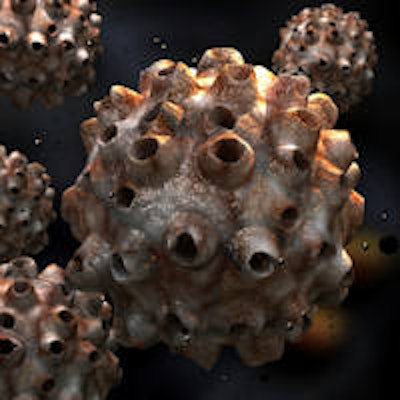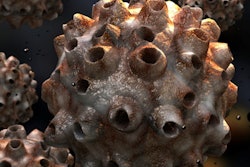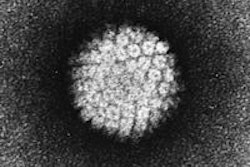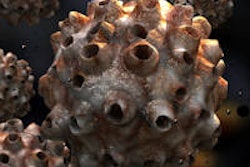
Vaccines that are currently available for the human papillomavirus (HPV) could prevent most oropharyngeal (OP) cancers in the U.S., according to a new study by the U.S. Centers for Disease Control and Prevention (Emerging Infectious Diseases, May 2014, Vol. 20:5, pp. 822-828). The retrospective study of patients with oropharyngeal squamous cell carcinoma (OPSCC) found that most were HPV-positive, especially for HPV types 16 and 18, and the majority of patients were white men.
The investigation was done to determine the prevalence of HPV types in OP cancers in the U.S. and establish a prevaccine baseline for monitoring the impact of vaccination.
The current worldwide incidence of OP cancers has been estimated at about 85,000 annually, although it varies extensively by geographic region. In the U.S., about 12,000 new OP cancers are diagnosed annually, and most are classified histologically as OPSCC.
 Mona Saraiya, MD, MPH, associate director, Office of International Cancer Control, Division of Cancer Prevention and Control, National Center for Chronic Disease Prevention and Health Promotion, CDC.
Mona Saraiya, MD, MPH, associate director, Office of International Cancer Control, Division of Cancer Prevention and Control, National Center for Chronic Disease Prevention and Health Promotion, CDC.In addition to tobacco and alcohol use, studies show that infection with HPV has been recognized as an independent risk factor for OP cancer.
CDC researcher Mona Saraiya, MD, MPH, the associate director of the Office of International Cancer Control in the Division of Cancer Prevention and Control at the National Center for Chronic Disease Prevention and Health Promotion, noted that it can take many years between HPV infection and the development of cancer, and many other factors may be responsible, including immunosuppression and multiple exposures.
Dr. Saraiya also pointed out that not everyone who has HPV gets cancer, and HPV usually goes away on its own.
"It is unclear if having HPV alone is sufficient to cause oropharyngeal cancers, or if other factors (such as smoking or chewing tobacco) interact with HPV to cause these cancers," Dr. Saraiya told DrBicuspid.com.
And the presence of HPV DNA does not confirm its causal role in carcinogenesis, the study authors noted.
"Because it is not clear at this point if HPV alone is sufficient to cause oropharyngeal cancer, factors other than use of tobacco products should be considered," the researchers wrote.
HPV vaccines
The two HPV vaccines approved by the U.S. Food and Drug Administration (FDA) protect against infection with HPV16 and HPV18, which are the high-risk types most frequently associated with cervical cancer. A candidate 9-valent vaccine that includes types in the existing quadrivalent vaccine (HPV types 6, 11, 16, and 18) and five additional high-risk types (31, 33, 45, 52, and 58) is in clinical trial, the study authors noted.
The median age for cervical cancer diagnosis is for women in their late 40s, but the vaccine is not recommended in late adulthood because by that time HPV exposure has already occurred, Dr. Saraiya said.
For oropharyngeal cancer, the median age of diagnosis is almost a decade later -- again because of the long time between exposure and actual cancer development.
Because of the lag time between HPV infection and cancer development, researchers concur with CDC recommendations that young females and males ages 11 to 26 get vaccinated with Cervarix (GlaxoSmithKline) or Gardasil (Merck).
Materials and methods
The study group included 588 OP patients who were diagnosed between 1995 and 2005 in seven cancer registries, including Florida, Kentucky, Louisiana, Michigan, Los Angeles, Hawaii, and Iowa. Most (94.4%) diagnoses were made during 2000 or later.
Fourteen HPV types (16, 18, 31, 33, 35, 39, 45, 51, 52, 56, 58, 59, 66, and 68) were considered to have a high risk for oncogenic potential, and all other types -- including an unknown type, HPV-X -- to be low risk, showing low or no known oncogenic potential.
Statistical analysis was restricted to patients that had confirmed invasive OPSCC.
Results
Most patients (77.6%) were from urban areas or counties with a population greater than 250,000 with a median age of 58 (range 28-97) years. There were three times as many men as women, and most patients were white. Squamous cell carcinoma (SCC), the most common histologic type of oropharyngeal cancer, accounted for 557 (94.7%) patients.
HPV was detected in more than 72% of OPSCC cases, and more than 71% were positive for one or more high-risk type. In 68.4% of cases, a single HPV type was found; 3.9% contained two types. In seven cases, only low-risk HPV types were detected: HPV11, 26, 69, 82 (two cases), 83, and HPV-X. HPV16 was found in 337 (60.5%) cases, HPV18 in 14 (2.5%) cases, and 331 (59.4%) cases were exclusively positive for these two types. HPV16/33 was the most frequent combination (six cases); HPV16/18 and HPV16/31 were the next most frequent, which were found in three patients each.
| HPV prevalence in oropharyngeal squamous cell carcinomas, select U.S. registries, 1995-2005* | |
| Variable | No. (%) cases, N = 557 |
| Characteristic | |
| HPV (any type) | 403 (72.4) |
| High risk† | 396 (71.1) |
| Low risk‡ | 7 (1.3) |
| Negative | 154 (27.6) |
| Single type | 381 (68.4) |
| Multiple types§ | 22 (3.9) |
| Type | |
| HPV16 | 337 (60.5) |
| HPV33 | 31 (5.6) |
| HPV18 | 14 (2.5) |
| HPV35 | 11 (2.0) |
| HPV39 | 5 (0.9) |
| HPV31 | 4 (0.7) |
| HPV52 | 4 (0.7) |
| HPV45 | 3 (0.5) |
| Other HPV types | 16 (2.9) |
† Positive for any of HPV types 16, 18, 31, 33, 35, 39, 45, 51, 52, 56, 58, 59, 66, and 68.
‡ Positive for types other than those identified as high risk.
§ HPV16/33 (6 cases), HPV16/18 (3 cases), and HPV16/31 (3 cases).
Source: U.S. Centers for Disease Control and Prevention.
HPV16 was found in more than 60% of OPSCC patients, HPV18 in 2.0%, other 9-valent high-risk types in 5.7%, other high-risk types in 2.9%, and low-risk types were detected in the remaining 1.3% of cases. Of the 15 patients for whom lymph node metastases were tested, 14 were positive for high-risk HPV and 13 were positive for HPV16.
The odds for high-risk HPV infections were significantly higher for all race groups than for non-Hispanic black people, the study authors noted. When only HPV16/18 was found, significant differences were found in sex and race/ethnicity, but not age, between those infected and those who were not infected.
“Awareness is important to relay to providers and parents so they are aware that there are many cancers that are associated with HPV and that can be potentially prevented by the HPV vaccine.”
In addition to differences by race/ethnicity, HPV prevalence also varied by sex, particularly for HPV16/18. Prevalence was 66% among men, notably higher than the 53% found among women, which was a finding consistent with results of other studies, the researchers noted.
The most noticeable differences were observed between racial groups, with notably fewer HPV-positive SCCs in non-Hispanic black people (50.7%) compared with non-Hispanic white people (73.6%), Hispanic persons (74.4%), or Asian Pacific Islanders (80.0%).
The study authors also noted that high-risk HPV types were detected in 80% of tonsillar SCCs.
"HPV and its relationship to oropharyngeal cancer is increasing as we have more research on this issue," Dr. Saraiya said. "I believe the awareness is important to relay to providers and parents so they are aware that there are many cancers that are associated with HPV and that can be potentially prevented by the HPV vaccine."
However, "I also feel there needs to be a balance between characterizing oropharyngeal cancer as an epidemic thus increasing anxiety," she added.
The study results further confirmed that HPV16, detected in 84% of all positive tissues, was by far the most frequent type found in oropharyngeal cancers.
Conclusion
"Our finding of more than 70% HPV prevalence in a large sample of the oropharyngeal cancer patients from around the U.S. suggests that a substantially higher faction may be HPV-related than has been reported in many previous investigations," the researchers noted. "Our current study results further confirm a trend of increasing incidence of tonsillar cancers with shifting demographic patterns."
The ability of HPV16 to establish persistent infection and its potential to transform might be responsible for its prominence in cancers, the study authors wrote.
There are currently no FDA-approved tests to diagnose HPV in the mouth or throat, Dr. Saraiya noted, and medical and dental organizations do not recommend screening for oral HPV.
"We are anecdotally aware that oral HPV tests are being promoted by dentists and other providers without any guidance or any FDA approval, which can lead to more harm than benefit," Dr. Saraiya said.
More research is needed to find out if screening for oropharyngeal cancers will have health benefits, she concluded.



















